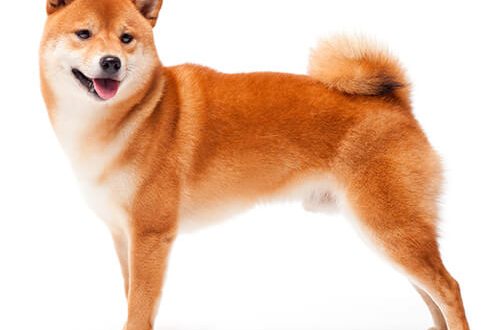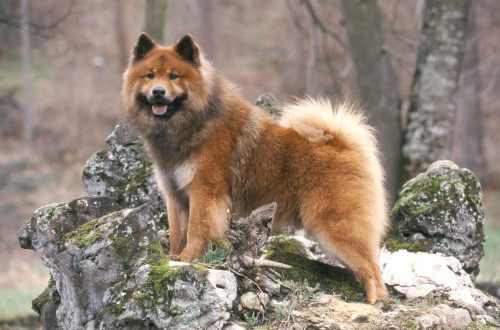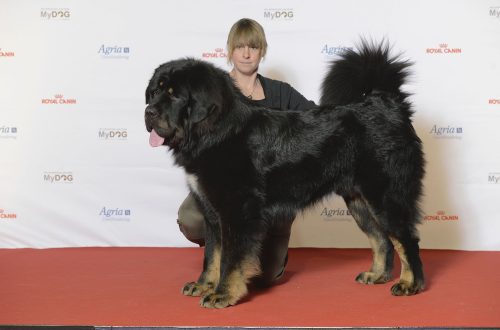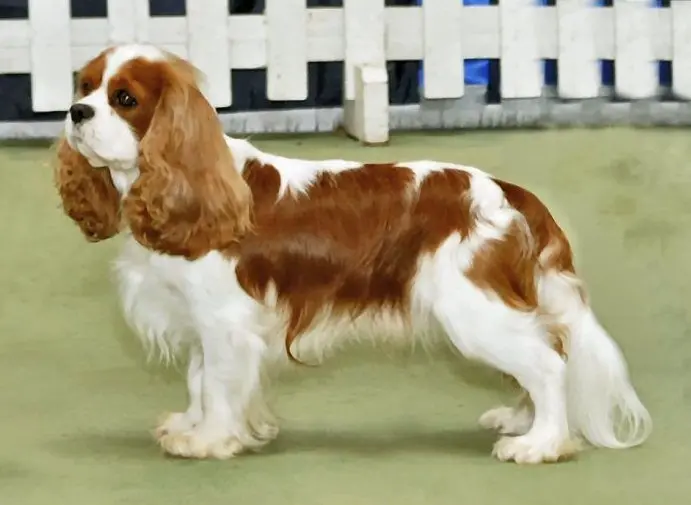
Cavalier King Charles Spaniel
Other names: cavalier
The Cavalier King Charles Spaniel is a cheerful, shaggy fidget with an expressive, flirtatious appearance and good-natured character. It will enliven any home with its own presence and will perfectly cope with the role of a reliable companion.
Contents
- Characteristics of Cavalier King Charles Spaniel
- Basic moments
- History of the Cavalier King Charles Spaniel
- Video: Cavalier King Charles Spaniel
- Appearance of the Cavalier King Charles Spaniel
- Photo of Cavalier King Charles Spaniel
- Personality of the Cavalier King Charles Spaniel
- Education and training
- Maintenance and care
- Health and disease of Cavalier King Charles Spaniels
- How to choose a puppy
- Photos of Cavalier King Charles Spaniel puppies
- How much does a Cavalier King Charles Spaniel cost?
Characteristics of Cavalier King Charles Spaniel
| Country of origin | Great Britain |
| The size | Average |
| Growth | 25–35 cm |
| Weight | 5–8 kg |
| Age | 12–15 years old |
| FCI breed group | retrievers, spaniels and water dogs |
Basic moments
- Cavalier King Charles Spaniels are virtually immune to mood swings. Affectionate and groovy, they are on the wave of positive 24 hours a day.
- Both adult dogs and puppies are extremely dependent on humans. Individuals experiencing a lack of master’s attention and remaining alone for a long time can mess up and make a mess. Partially solves the problem of buying a second “cavalier” – it is easier for two animals to cope with boredom.
- Leadership and a desire to dominate are qualities that Cavalier Kings have never heard of, which is why they never fight with other dogs for “spheres of influence”.
- Representatives of this breed are typical extroverts, seeing in everyone they meet a future friend, to whom they are happy to entrust any secrets.
- Pets love tactile contact. Stroking, rubbing, scratching the Cavalier King Charles Spaniel is not only acceptable, but also very desirable. For this reason, dogs bond closely with children. They are not annoyed by too strong hugs of babies, moreover, animals are sincerely glad to them.
- Cavalier King Charles Spaniels get along well with cats. That’s just the representatives of the purring fraternity are not always ready to put up with the presence of these annoying handsome men on their territory.
- Most Cavalier Kings have retained the hunting instincts inherited from their ancestors, so do not be outraged if the dog starts actively chasing a lizard or a kitten on a walk.
- A few years ago, the popularity of the breed in Britain began to gradually decline. But in Russia, things are exactly the opposite: the interest of domestic breeders in Cavalier King Charles Spaniels has increased dramatically over the past couple of years.
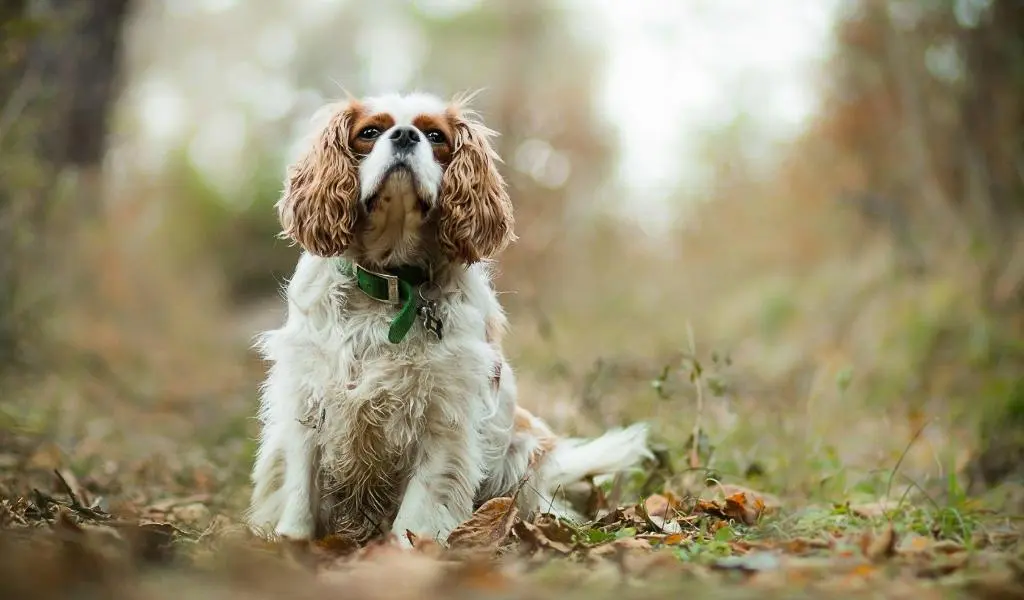
The Cavalier King Charles Spaniel is an affable smart dog with a penetrating look and a long satin coat, ready to “drown” anyone who is in sight in the sea of his own charm. These energetic, outgoing sympathizers make exceptional friends. Cheer up, laugh, relieve stress – all this dogs are ready to do for the owner every day in exchange only for a kind word and affection. Not without reason, in the homeland of the breed, in England, the reputation of professional comforters has long been established for Cavalier Kings.
History of the Cavalier King Charles Spaniel
Due to the similarity of names, the Cavalier King Charles Spaniel is often identified with the King Charles Spaniel. And yet, despite the common Asian ancestor, these are two independent breeds with significant differences in the phenotype. If you do not go into the subtleties of selection, then the Cavalier King is a thoroughly “reshaped” King Charles, which was born as a tribute to British cynological traditions. At the same time, Tibetan spaniels are considered the progenitors of both breeds.
From about the middle of the 9th century, the European nobility became interested in the ancestors of today’s “kings” and “cavaliers”. Toy spaniels sat in the boudoirs of baronesses and duchesses, Titian and Van Dyck raced to paint their portraits, and the bloodthirsty tyrant Henry VIII even recognized the right of animals to be at court. With the ascension to the British throne of Charles II, the breed added the prefixes king and charles to its name and began to enjoy an almost unlimited list of privileges. Why, spaniels were even allowed into the holy of holies – the British Parliament!
The line of King Charles began to inevitably fade away with the coming to power of William III of Orange. The new monarch set up his own rules at court, settling in his chambers a “party” of pugs, whom he sincerely adored. The rest of the London beau monde immediately rushed to imitate the predilections of the crowned person, as a result of which short-faced, bug-eyed dogs came into fashion. Toy spaniel breeders also did not stand aside: in order to please the picky aristocrats, they began to cross their own pets with pugs and Japanese chins. Ultimately, by the 20th century, the exterior of the animals had changed so much that only the most sophisticated specialist could see the former King Charles in snub-nosed, big-eyed dogs.
In the mid-20s, European breeders decided to revive the old type of English Toy Spaniel. Around the same time, the British Kennel Club approved a cash prize for a breeder who, within the next five years, will manage to breed a classic variety of King Charles. As expected, the promise of an award fueled the interest of breeding specialists, and already in 1928, the first “copy” of a King Charles Spaniel of traditional European appearance was presented to the canine commission. The animal had an elongated muzzle and normally set eyes, bringing it closer to the dogs from the canvases of Edwin Landseer.
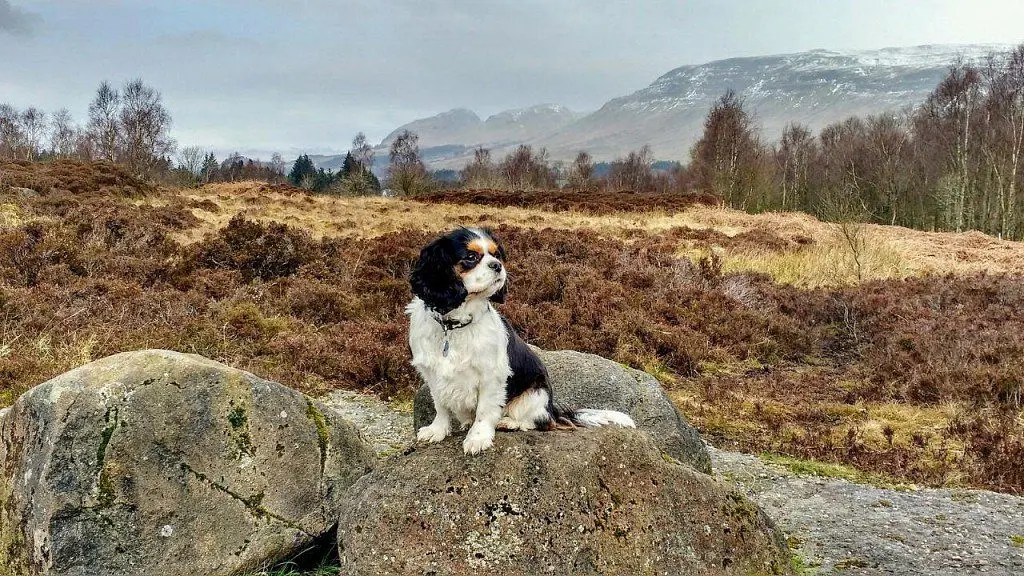
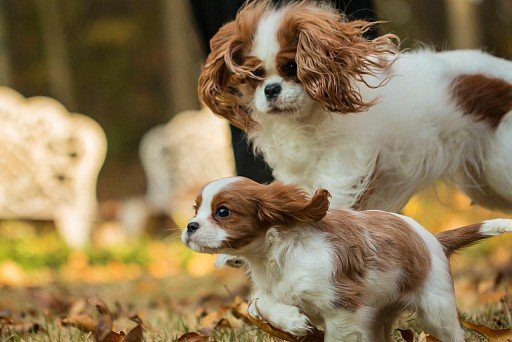
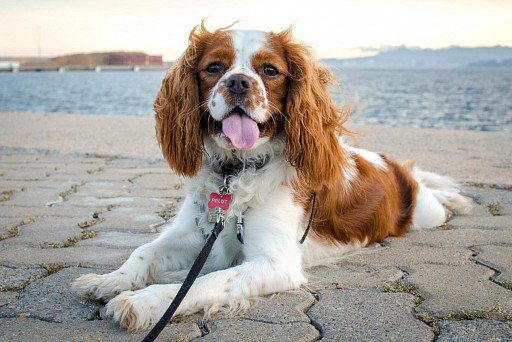
To avoid confusion in the future, the revived breed was given a new name. Thus, the Cavalier King Charles Spaniel clan spun off from the King Charles tribe. By the way, the prefix cavalier- was not chosen by chance. During the English Revolution, this was the name of the supporters of King Charles I, under which the breed truly flourished. In 1945, Cavalier Kings were entered into the registers of the COP, after which they began to gain popularity in other European countries. The favorites of the British monarchs made their way to Russia even before the revolution, although they began to fully breed them only in 1986.
For your information: over the years, Ronald Reagan, Johnny Depp, Frank Sinatra, Teri Hatcher, Natalie Wood and Hugh Hefner were fans of the Cavalier King Charles Spaniel breed.
Video: Cavalier King Charles Spaniel
Appearance of the Cavalier King Charles Spaniel
Both King Charles and Cavalier Kings belong to the English Toy Spaniel section, but, as mentioned earlier, have significant differences in conformation. Cavalier King Charles Spaniels are larger (from 5.5 to 8 kg) and tall (up to 32 cm at the withers). The muzzles of dogs are moderately elongated, and the eyes are devoid of the bulge that their relatives inherited from pugs and other Asian breeds.
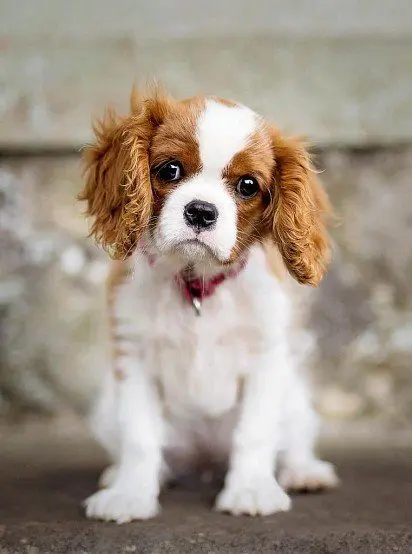
If the “kings” attract with their pronounced orientation, then the “cavaliers” – with their unique grace and truly European charm. Silky, straight or slightly wavy coat, sparkling look and elegance of movements make them ideal pets for all lovers of glamorous breeds. In addition, Cavalier Kings are born fashion models. You can shoot them sleeping, slicing through a dandelion lawn, or sitting on the arms of their owner and not worry about the shot being unsuccessful. These “British aristocrats” are photogenic anywhere, anytime and in any mood.
Head
A small, flat skull between the ears with a shallow stop. Muzzle in the form of a cone. The distance from the tip of the muzzle to the stop is no more than 3.8 cm.
Ears
The Cavalier King Charles Spaniel has long, high-set ears. The outer side of the ear cloth is covered with abundant dressing wool of a silky type.
Eyes
Round, but without noticeable bulge. Large and very dark.
Nose
Lobe large, uniform black color.
Jaws and teeth
Cavalier King Charles Spaniels have powerful jaws with a scissor bite (the lower teeth are completely covered by the upper ones).
Neck
Normal length, with a slight bend.
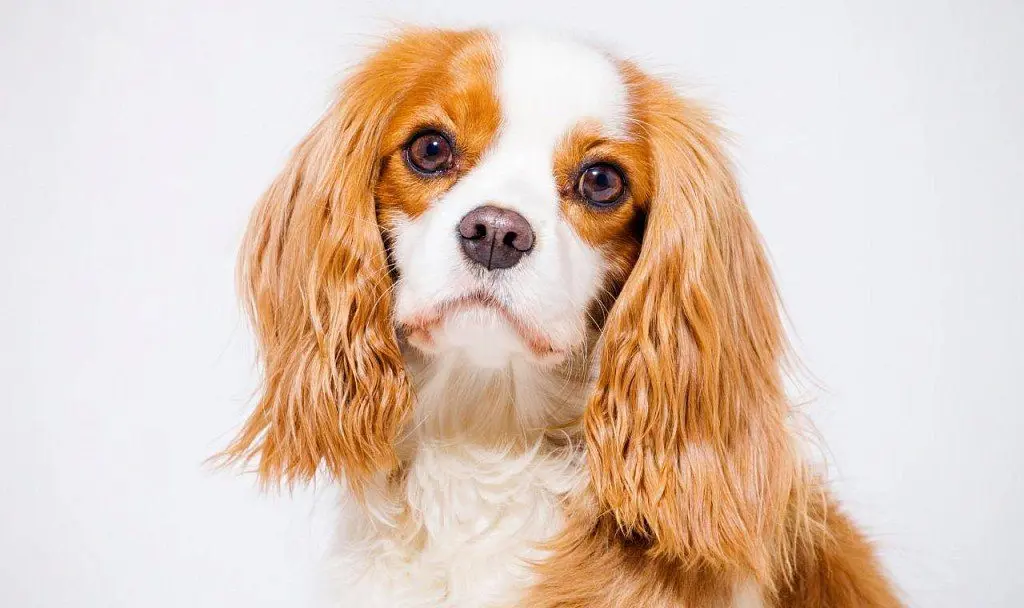
Frame
Compact body with a short lumbar zone, a flat back and a normal chest width.
limbs
The fore and hind legs are moderately boned and even. The paws of the Cavalier King are miniature, very soft, with the toes almost completely hidden by long dressing hair.
Tail
It is held at the level of the back or slightly higher. Previously stopped at ⅓, which is almost never practiced these days.
Wool
Silky to the touch and very long. Straight hair is considered a reference, but a slight waviness of the coat is also quite acceptable.
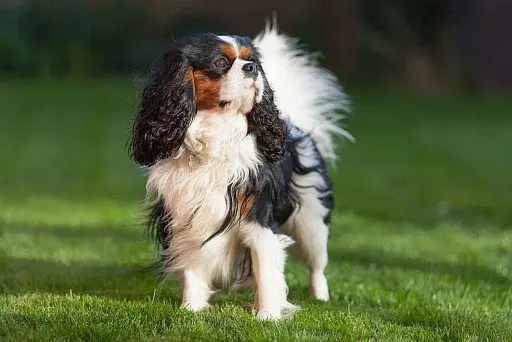
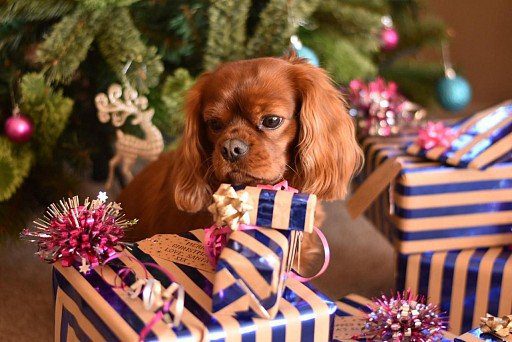
Color
The following color types of Cavalier King Charles Spaniels are officially approved:
- blenheim (expressive chestnut spots on a white background);
- black and tan;
- ruby (rich red hue);
- tricolor (black with white and red tan marks on the eyebrows, cheekbones, back of the legs, ears and under the tail).
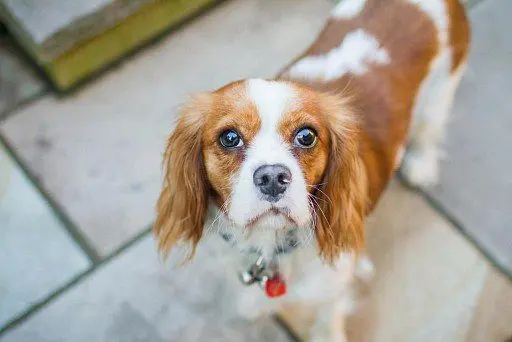
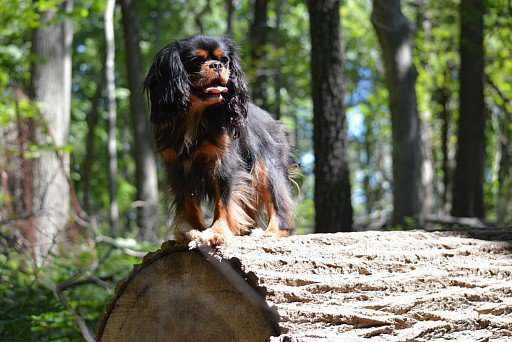
Disadvantages and possible defects
It is allowed to consider all individuals that have deviations from the breed standard as defective. Of course, most of the external shortcomings do not block the access to exhibition events for the animal, but the chances of getting an excellent mark are reduced to almost zero.
Another thing is malformations. The dog in which they are found will not be accepted at any show. If we talk specifically about Cavalier Kings, then they are disqualified for underweight / overweight, non-standard colors and depigmented nose. Animals with a cleft lip, atypical bite and incorrect gait (hackney, amble) will also have to forget about a show career.
Photo of Cavalier King Charles Spaniel
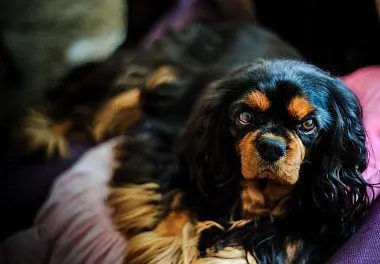
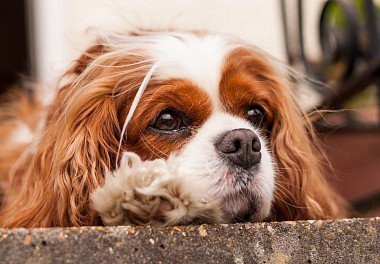
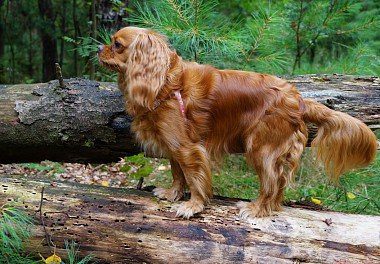
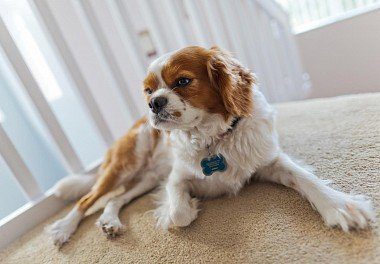
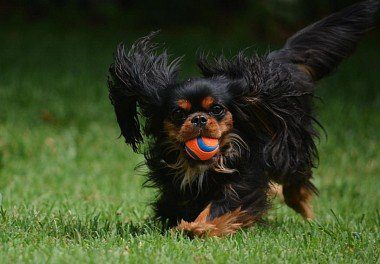
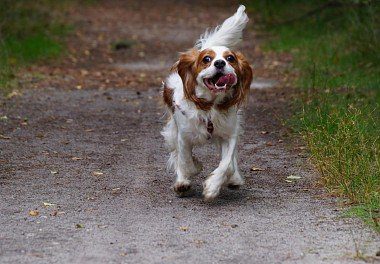
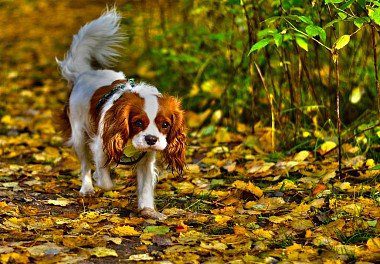
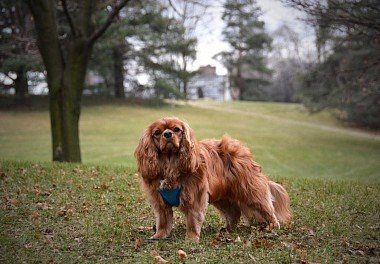
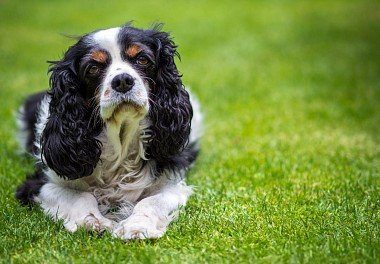
Personality of the Cavalier King Charles Spaniel

Cavalier King Charles Spaniels are the best healers of blues and bad mood. They are literally “turned” to communicate with a person and are completely unprepared to play the role of an outside observer in the family in which they live. Despite the generally not the most outstanding dimensions, there are always a lot of “cavaliers” in the house, as they are extremely curious and try to delve into everything that happens not only before their eyes, but also behind their backs.
The breed’s need for human attention can be a little annoying to the owner, who does not have the opportunity to constantly contact the pet or is tired of an overabundance of communication with him. That is why breeders recommend Cavalier King Charles Spaniels for large families with several generations of relatives. So it will be easier for the dog to choose a company for himself, without overloading one person with his sociability.
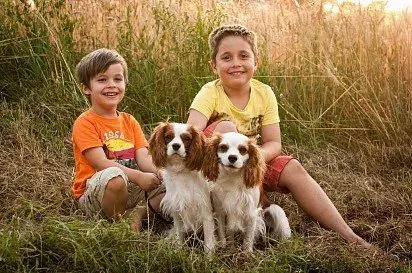
Due to natural curiosity and goodwill, the “cavalier” treats anyone, even an unfamiliar person, so trusting him with the protection of his own home is a deliberately unsuccessful undertaking. Bribing this frisky “Englishman” is as easy as shelling pears: just chat with him affectionately or play a little. Such a feature of the breed as sonorous barking also does little to help the animal in security activities. Cavalier Kings demonstrate their vocal talents more often in games than in case of real danger, so forget about raising a decent watchman out of this glamorous major.
In relation to other pets, Cavalier King Charles Spaniels are unparalleled charms. They are completely devoid of leadership habits and the desire to dominate everything that moves, so they will gladly hand over the “reins of power” to any four-legged creature that wishes it. A purebred “cavalier” will get along with another dog, cat or some exotic creature without any problems, provided that they do not try to take away his status as a universal favorite.
Education and training
Cavalier King Charles Spaniels are very smart and easily comprehend all the subtleties of the educational process, which does not prevent them from turning on the “non-understanding” mode from time to time. Often, owners fall for this dog trick and bombard specialized forums with questions like: “Why doesn’t Cavalier King follow commands?” The reason for this behavior lies not in the obstinacy of character, but in banal boredom. Perhaps you just overdid it with the severity and duration of the training, tiring the dog. Or they simply did not take into account the peculiarities of her temperament.
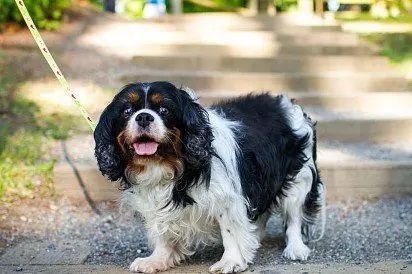
Cynologists assure: it is necessary to train the Cavalier King Charles Spaniel in the game and, if possible, affectionately. Most of these British “aristocrats” are inherently shy, so if you raise your voice during training for a pet, he may permanently refuse to participate in classes. To warm up interest in training is also not forbidden. To do this, a supply of your dog’s favorite treats is enough.
“Cavaliers”, despite the rather mild and peaceful nature, in the soul are not alien to some robbery habits. For example, having met a cat or a rodent on a walk, the dog will definitely try to chase him. Moreover, not every such “hunt” ends with the happy return of the pet. Overwhelmed by the excitement of the pursuit, the cavalier king can easily get lost, so the “Fu!” and “Near!” with a pet should be learned in advance and as firmly as possible.
From 4-5 months of age Cavalier King Charles Spaniels show class begin to accustom to the exhibition stand. First, the success of the animal is rewarded with a treat. And only after the puppy has formed a stable association: stand = treat, you can use the “Stop!” command.
Note: Experienced handlers do not recommend teaching the Cavalier King Charles Spaniel the “Sit!” command. until the animal participates in exhibition events. Shuffling in an unfamiliar environment, the pet can confuse the meaning of the commands and, instead of the stance required of it, issue the opposite action.
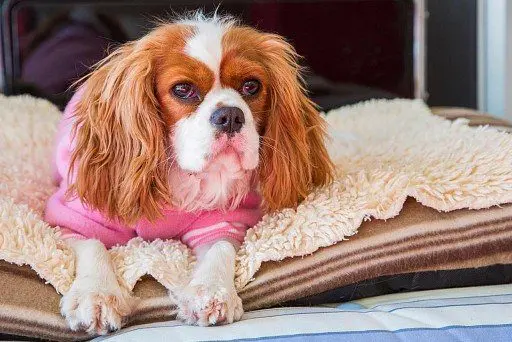
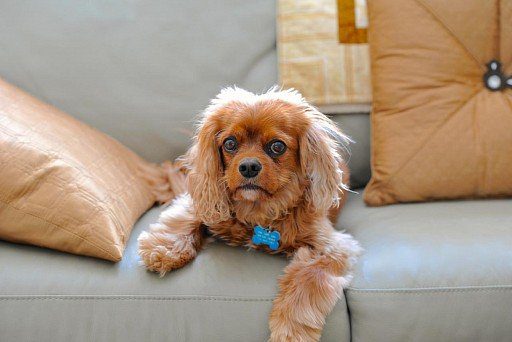
Maintenance and care
The first thing that the owners of future champions should pay attention to is the flooring materials in the house. On slippery parquet or laminate, the puppy’s paws will move apart, which will become a prerequisite for the formation of an incorrect gait and set of limbs. It is best if the floor in the room is covered with a thick carpet or rugs, since Cavalier King Charles Spaniels are exclusively apartment dwellers. On the street, they only walk and go to the toilet.
If you sometimes have to leave your pet alone, buy him an aviary and teach him to sit in it. So the animal will be deprived of the temptation to gnaw shoes or bite computer wires in your absence. Dogs of this breed are transported in cages, to which the pet will also have to be accustomed.
Important: do not use a cage and an aviary as a punishment in cases where the Cavalier King Charles Spaniel is too “tired” of you with excessive sociability. The dog will quickly figure out what the true purpose of this accessory is, and earn himself an additional phobia.
Hygiene
Cavalier King Charles Spaniels are not customary to shear. It is also not worth combing them too often: the wool of representatives of this breed has a silky texture and is almost not tangled. Just brush your baby’s “fur coat” and enjoy the freedom from this duty for 5-7 days. Another thing is the molting period. At this time, the hair of the “cavaliers” needs to be combed daily.
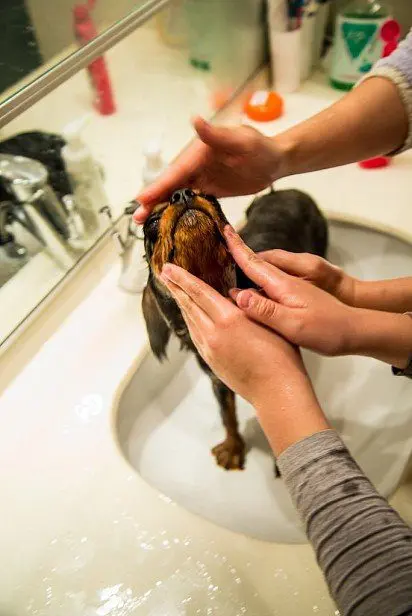
You can smooth the animal’s hair with a mitten: this is how dirt, dust and dandruff are removed from it. Fluffy “footprints” left by Cavalier King Charles Spaniels on sofas and carpets are also easy to deal with. Even the most powerful vacuum cleaner sucks up the hair of these dogs without any problems. In addition, the wool of the “cavaliers” practically does not smell like a dog.
The frequency of bathing a dog is determined by its class. Show individuals are washed once a week using a whole arsenal of products for smoothing and nourishing the hair, as well as giving it a noble shine. For pets, it is enough to take a bath once a month with shampoo and conditioner to make combing easier. And don’t forget: the maximum allowable water temperature for a Cavalier King Charles Spaniel is 39°C. The washed animal is wiped with a towel and dried with a hairdryer. It is strongly not recommended to wrap the dog in a diaper and leave it to dry in it. Such experiments lead to aging of the hair and its subsequent loss.
The most problematic organ of the Cavalier King Charles Spaniel is the ears. Due to their hanging position, they are poorly ventilated, but they actively accumulate sulfur and pollution, so it is better to inspect and clean them more often. The pet’s eyes should be checked every day, removing debris and mucus accumulating in their corners with a cotton sponge. In case of inflammation, the eyes can be wiped with chamomile decoction. If the inflammation is pronounced, it is not forbidden to drop a couple of drops of albumin onto the mucous membrane. But from tea infusion and a solution of boric acid, which are recommended to be used by “home-grown ophthalmologists” on cynological forums, it is better to completely refuse.
The teeth of the representatives of this breed are brushed twice a week, the claws are trimmed once every two weeks. After a walk, the paws of the Cavalier King Charles Spaniel must be washed, and in winter they are smeared with vegetable oil or cream to protect them from the toxic effects of reagents.
walks
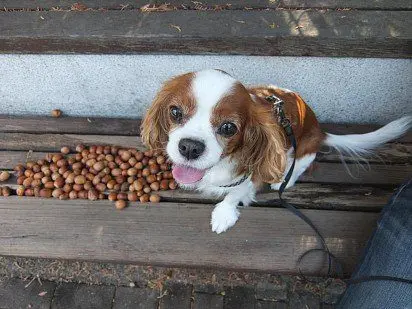
Until the age of 4 months, Cavalier King Charles Spaniels are taken out for walks as often as possible to teach them to go to the toilet outside. Starting from the 4th month of life, the number of walks is reduced, but their duration is increased. It is important to remember that cavalier kings do not need intense physical activity and too long promenades, but just standing with a pet under a tree will not work either.
It is better to walk the dog in areas where there is no asphalt. There, the animal can run properly without the risk of overworking and injuring the paws. If you really want to walk along the sidewalks with the “cavalier”, do not exceed the optimal limit of 40 minutes for such walks.
Feeding
“Natural”, “dry”, or both – all of these types of feeding are considered acceptable for Cavalier Kings. And yet, most experts prefer a natural diet, as more useful. When designing a menu for your own pet, keep in mind that the Cavalier King Charles Spaniel is a breed prone to obesity. With an excess amount of high-calorie food, the dog will instantly gain weight, but it will not always be able to lose it.
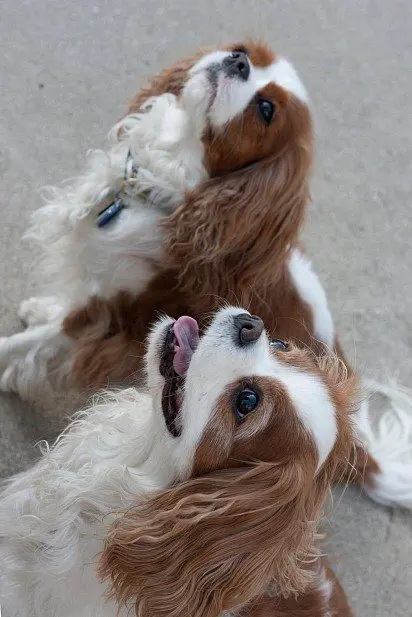
Necessary, in terms of benefits, products for “cavaliers” are lean meats, cereals, as well as low-fat sour milk. By the way, this breed is very partial to “vegan” dishes, so in the summer season, often add vegetable stew, fruit cuts and salads to your pet’s diet. In addition, many cavalier kings willingly eat berries, ground cucumbers and zucchini. From time to time it is useful for dogs to give a yolk or a quail testicle.
Prohibited Products:
- sweets;
- sausages;
- salty and spicy dishes;
- tubular bones;
- pork and any fatty meats;
- sour cream and cream;
- mushrooms;
- onion and garlic;
- legumes;
- pastries and white bread;
- River fish;
- pearl barley.
Owners who decide to treat the animal with industrial feed should not forget about the breed’s predisposition to food allergies. In this case, you can only protect your pet by carefully studying the composition of the feed, so immediately discard the varieties in which “traces of the presence” of chicken or cereals were found.
Toilet
Cavalier King Charles Spaniels are difficult to accustom to the tray, so representatives of this breed have two options for the administration of “needs”: street or diaper. To instill in your pet the habit of going to the toilet during a walk, he is taken outside immediately after eating or sleeping. If the method turns out to be ineffective, you can add a newspaper or a piece of cloth to it, on which the dog went “in a small way” at home. Interested in a familiar smell, the animal usually remembers its own needs and sits down next to the wet diaper. Never scold the cavalier king for puddles in the apartment, while exaggeratedly praising the dog for doing his “things” outside the house is very useful.
Health and disease of Cavalier King Charles Spaniels
All hereditary diseases of Cavalier King Charles Spaniels are the end result of so-called line breeding and a too limited genetic base. First on the list of ailments that affect about half of the “cavaliers” aged 5 years and older is myxomatous valve degeneration or prolapse. The second scourge of the breed is syringomyelia (Chiari syndrome). An animal that has inherited this disease experiences discomfort and severe pain in the region of the cervical spine, which, if not treated in time, leads to “neck twisting”.
The episodic fall syndrome is more difficult to diagnose than the previous two ailments, which does not at all prevent it from affecting a huge number of animals. The behavior of cavalier kings suffering from this disease is somewhat similar to the habits of dogs with a back injury. They freeze in place for a long time, arch their backs when running and tighten their limbs when lying on their side. Another weak point of the breed is the joints. Patellar instability progresses with age in many Cavaliers, most commonly in bitches. Dry eye and curly coat syndromes, which are very difficult to treat, spoil the life of pets.
How to choose a puppy
When choosing a Cavalier King Charles Spaniel puppy, you can be guided by the same principles as when buying any other purebred dog.
- Do not take babies from nurseries in which unsanitary conditions and disorder reign.
- To insure yourself against buying a sick animal, ask the breeder for the results of tests aimed at identifying genetic diseases in the puppy (dry eye syndromes, curly coat, episodic falls).
- The temperament of the Cavalier King Charles Spaniel is independent of gender. Both females and males of this breed are equally affectionate and attached to the owner, so choose the animal according to your own preferences.
- Get to know the puppy’s parents and their pedigree to avoid buying an inbreeding (closely related) animal.
- Choose a frisky, inquisitive baby who shows a keen interest in toys. Lethargy and indecision in Cavalier King Charles Spaniel puppies indicate their physical and psychological exhaustion.
Photos of Cavalier King Charles Spaniel puppies
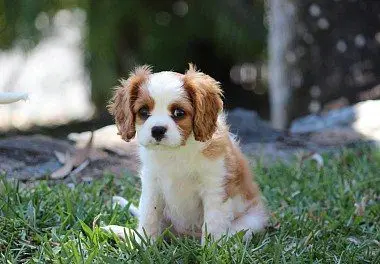
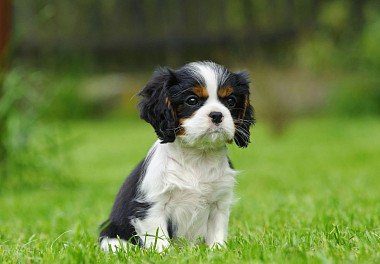
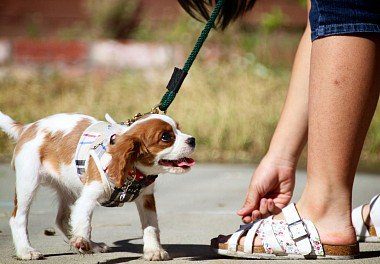
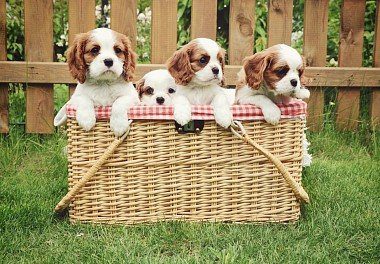
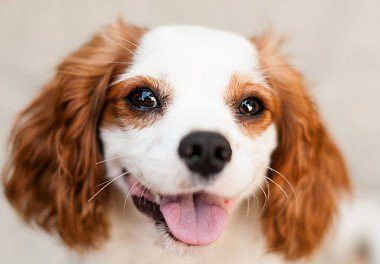
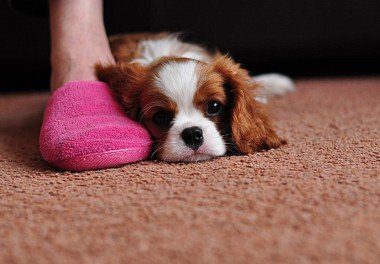

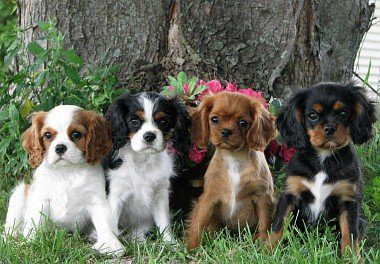
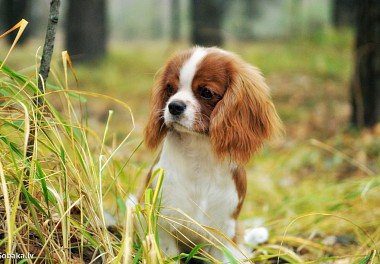
How much does a Cavalier King Charles Spaniel cost?
The cost of Cavalier King Charles Spaniel puppies directly depends on their pedigree and external parameters (class). Domestic breeders have an average price tag for a baby with a veterinary passport and RKF metric – 500 – 600$. Prices for individuals with a reference appearance, promising in the future to collect all conceivable and unimaginable champion titles, start from 900$. The most expensive, according to tradition, are puppies from interbreeding (male and female – from different countries). Such pets can cost 1100$ and more.



